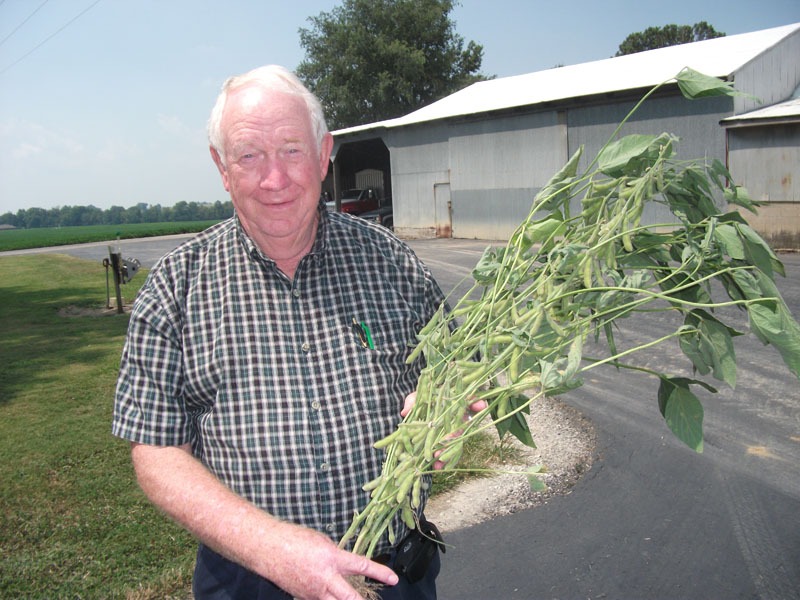Soil-Matters Spring 2009
No Small Feat

Indiana Producer Ron Small Pushes Soybean Yields to the Limit
Nestled between the White and Wabash rivers in Southwestern Indiana near Monroe City, Small Farms grows corn, soybeans, & wheat on about 6,000 acres of lightly rolling fields.
Small Farms, INDIANA (2009) – Ron Small has achieved what soybean breeders and University geneticists only recently predicted farmers wouldn’t see for another five years — consistent 100-bushel soybeans. He’s done it three years in a row.
Ron broke the 100-bushel barrier in 2006, with 342 soybean acres averaging 100+ bushels per acre, including one 42 acre farm that yielded 118 bushels.
“That first field I made 118 bushels on had [pod] clusters like grapes — each one with four beans to the pod” Ron says.
In 2007, Ron did it again with a 25 acre field of soybeans yielding 100 bushels per acre and a total farm average of 80-bushels per acre, overall.
2008 marks Ron’s third consecutive year to raise triple digit beans with one field yielding 114-bushels per acre.
One of the largest producers in southwestern Indiana, Ron has more than 45 years experience in production farming.
Along the way he discovered several management tools that work together synergistically to improve yield potential.
One such tool is Pro-Soil’s Foundation 1-0-1. This has been his primary soil builder for the last seven years.
Ron says, “Pro-Soil enhances my crops more than probably anything I’ve done In the last 40 years I’ve been in agriculture.”
“Over the past seven seasons we have gradually cut back on fertilizer, herbicides and insecticides. Our ground has improved every year and our yields have actually increased,” he says,
“The best thing is that we’re spending less money per acre and we’re raising healthier crops.”
Ron sums up his system for growing 100+ bushel soybeans In eight simple steps:
1. TREAT 100% OF YOUR ACREAGE WITH PRO-SOIL PRODUCTS. Ron broadcasts 12.8 ounces of ?? foundation 1-0-1 with his first Roundup Pass.
2. Plant Early. (Between April 5th and the 15th in Southern Indiana) to take advantage of more pod-creating sunlight while avoiding the stress of hot days.
3. PLANT 15 INCH ROWS. This reduces early season competition from neighboring plants and provides maximum access to sunlight.
4. SELECT AN EALIER BEAN VARIETY. Ron plants a 3 to a 3.6 maturity – which us considered an earlier bean variety for southern Indiana. He suggests growers further north “Could probably consider a 2.7 to a 3”
5. COAT THE SEED WITH AT LEAST THREE DIFFERENT INSECTICIDES.
6. LIME AT THE RIGHT PH FOR YOUR SOIL. “I’ve even applied 2 ton of lime and then turned around and used pail lime whenever I planted — plus 100lbs of potash with that.
7. APPLY FUNGICIDES AT THE RIGHT TIME.
8. CUT BACK ON FERTILIZER*. Ron has reduced the amount of fertilizer he applies by about around $25 per acre. “I’m also using 25% less pesticides.” he says.
* Following Pro-soil’s Gradual Reduction Program over time. Consult with your Pro-Soil Representative for details.
Small Farms (2006) – An agronomist from Campbell’s Seed verifies 118 bushel soybean yield on 42 acre farm belonging to Ron Small. Overall, 342 total soybean acres averaged 100+ bu./ acre that year.
